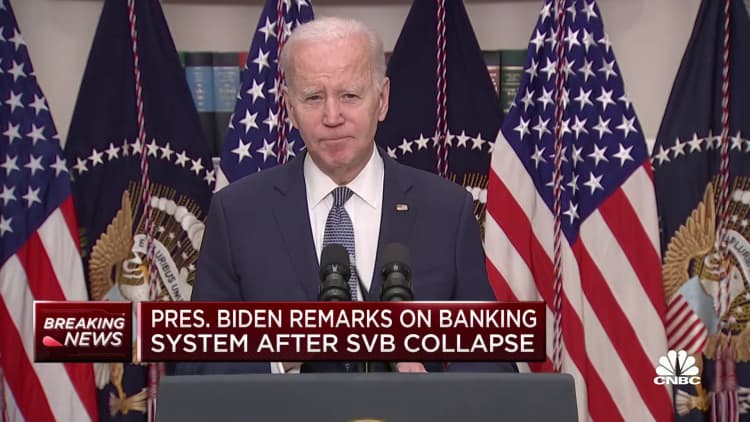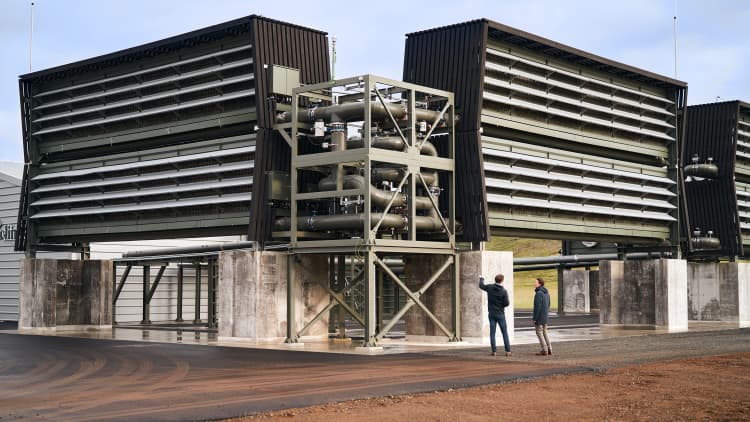A view of Silicon Valley Bank headquarters in Santa Clara, CA, after the federal government intervened upon the bankâs collapse, on March 13, 2023.
Nikolas Liepins | Anadolu Agency | Getty Images
Silicon Valley Bank was the go-to bank for startups seeking bankers who understood the startup life and balance sheets. That was especially true for the cohort of startups being built and scaled to address climate change.
After a very stressful weekend for many startup founders and investors, banking regulators hatched a plan to backstop SVB’s deposits, ensuring that depositors won’t lose their money.
Founded in 1983 specifically to help startups, SVB had a strong and established business in climate, boasting 1,550 climate tech and sustainability clients, according to its website.
“Silicon Valley Bank had a very good reputation in the energy transition space and were willing to put their money where their mouth is, unlike many of their peers,” said Mona Dajani, the head of renewable energy and infrastructure law at Shearman & Sterling.
“Many clean energy companies banked with SVB because they had an established and dedicated clean energy practice and they were perceived to have more experience in the clean energy space than most regional and big bulge bracket peers,” Dajani told CNBC.
But the climate space has grown up since SVB started, and that paves the way for new lenders to serve the market.
“Fundamentally, the companies that are coming out of climate right now have real strength. These are foundational companies, and people are going to want to lend to them because it’s good business,” explained Katie Rae, the CEO of The Engine, an accelerator and venture fund focusing on “tough tech,” including climate startups.
“Just in the last three days, I probably have 50 emails in my inbox from different providers saying, ‘Hey, I know SVB is not in good shape. We also do venture debt.’ So many are going to emerge,” Rae told CNBC in a phone conversation on Tuesday.
Wind turbines operate at a wind farm, a key power source for the Coachella Valley, on February 22, 2023 near Whitewater, California.
Mario Tama | Getty Images
Understanding how startups work
Venture-backed startups are an unusual type of business. In their early stages, they might not have cash flow, revenues or even customers. Instead, they rely on venture funding, where investors offer cash in exchange for equity, hoping that the startups prove out their technology, find customers and eventually grow into giants.
Providing banking to those kinds of customers requires special skills and an appetite for risk.
“Nobody understands startups as well as Silicon Valley Bank and how to lend to them,” says Zachary Bogue, a longtime tech investor and co-founder of DCVC.
“I envision a startup’s application getting simply annihilated by a big bank’s risk committee,” Bogue told CNBC.
That was exactly Bill Clerico’s experience back in May 2009. When Clerico moved to Silicon Valley with Rich Aberman to grow their fintech company, WePay, they had a Bank of America small business account, but the account didn’t have the services the startup needed.
“Silicon Valley Bank understood that even though we may have only had $10,000 or so in deposits at the time, we had a lot of potential,” Clerico told CNBC.
As it turned out, SVB was right to bet on Clerico. WePay was acquired by JPMorgan Chase in December 2017.
“That early investment in our relationship paid off,” Clerico told CNBC. “Over time our deposit balances grew to hundreds of millions, we borrowed millions from them in venture debt and we processed billions through their accounts.”
In January 2022, Clerico launched Convective Capital, a $35 million venture capital fund investing in wildfire technology. He ardently hopes somebody can fill the gap left by SVB.
“Some folks may conflate their balance-sheet-driven meltdown with the failure of this startup-focused business model — but in fact, I think that banking startups continues to be a great business and a role that someone needs to fill,” Clerico told CNBC. (Notably, Clerico is an angel investor in Mercury, a startup working to meet this need.)
“I hope SVB and their business model persists in some form,” Clerico said.

The ‘1,000-pound gorilla’ of venture debt lending
In the climate tech ecosystem, SVB was especially prominent in making loans to companies with venture capital funding, known as “venture debt.” It’s essential for startups that are still not generating enough cash flow to be self-sustainable, especially when they are between funding rounds.
“It adds a little bit to the capital that they’ve raised, extends their runway a little bit and gives them more time to make progress on their business,” Rae told CNBC. Venture debt can add between three to six months to the runway companies already have, Rae said.
“There are other places that do venture debt, but Silicon Valley Bank was the 1,000-pound gorilla in the room,” said Ami Kassar, the CEO of the business lending consultant Multifunding.
“The concern now is that even in instances where deposits are made whole, the credit facilities for companies with SVB are likely no longer available, and this is a sector where those are critical,” Dajani said.
That said, making loans to venture-backed companies is a riskier endeavor than traditional banking, Kassar told CNBC.
“I always wondered how they managed to have the regulators allow them to have such a heavy concentration of venture debt,” Kassar said.
Solar panels are set up in the solar farm at the University of California, Merced, in Merced, California, August 17, 2022.
Nathan Frandino | Reuters
Climate is good business
SVB was an early supporter of climate technology, helping a lot of climate tech companies get off the ground. But as the sector has matured, participants believe other financiers will be more willing to lend to those companies.
“Silicon Valley Bank’s early support and commitment to supporting climate tech startups certainly helped catalyze the enormous migration of capital that you’re now seeing deployed into the sector,” Adam Braun, a founder of the climate startup Climate Club, told CNBC.
For instance, SVB provided financing to 60% of community solar projects, said Kiran Bhatraju, the CEO of Arcadia, a climate technology company that, among many services, helps people connect to community solar projects.
In this, the bank “was a climate bank pioneer,” said Steph Speirs, co-founder and CEO of Solstice Power Technologies, which has built a technology to help make solar projects accessible.
“But renewables have come a long way in the last decade and there’s now a much wider universe of potential financiers looking to get on board,” Speirs said.
That’s what Braun expects to see, too.
“I believe we’ll see many more institutions build dedicated climate practices and funds to support startups emerging in this space,” Braun told CNBC. “While SVB may have been a first mover, I don’t think the events of last week will diminish the desire to finance and support the emerging companies that are leading the rapidly growing climate tech sector forward.”
First Republic and JPMorgan are “increasingly making this category a priority,” Chauncey Hamilton, a partner at the venture capital firm XYZ, told CNBC. “More and more banks are paying attention to climate,” Hamilton said.
Mark Casady, a founder of the venture capital firm Vestigo Ventures, agrees.
“Climate solutions are too powerful a force to be stopped by the failure of a bank,” Casady told CNBC. “The need is critical and time is not on our side to find solutions. Since this is a fundamental need, it will get more backing rather than less.”
That transition will take time, however. And for companies working to combat global warming, time is the ultimate enemy.
“I do expect big banks to ultimately step up and provide the financing the industry needs to move forward — these projects are just too attractive and the promise of climate tech is too great. But it will take some time, and delays can be costly in the fight against climate change,” Bhatraju told CNBC.
“With all the new investment in climate tech and the opportunities ahead afforded by the IRA [Inflation Reduction Act], there is a ton of momentum. We don’t want to lose that,” Bhatranju said.

Correction: A previous version of this story misspelled Chauncey Hamilton’s name.
